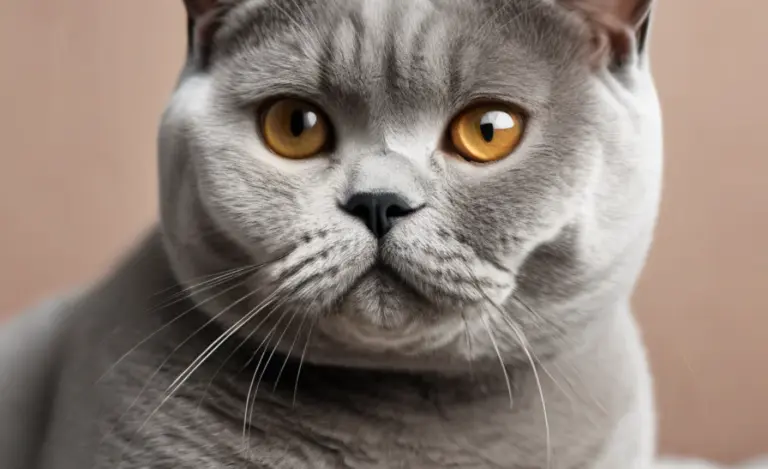British Shorthair Grooming Tips for Winter: Easy!
Quick Summary
To keep your British Shorthair happy and healthy during winter, focus on regular brushing (2-3 times a week) to prevent matting caused by their thicker coat. Adjust their diet to avoid weight gain from less activity, and maintain a comfortable indoor humidity to prevent dry skin. Provide extra cozy bedding and monitor for any signs of winter-related health issues like respiratory problems.
Winter can be a magical time of year, filled with cozy nights and festive cheer. But for our beloved British Shorthairs, the change in season brings unique grooming challenges. As the temperature drops, their luxurious coats thicken to provide extra warmth, which can lead to increased shedding and matting. Plus, drier indoor air can cause skin issues, making proper grooming even more essential.
Don’t worry! With a few simple adjustments to your grooming routine, you can ensure your feline friend stays comfortable, healthy, and looking their best all winter long. This guide will walk you through everything you need to know, from brushing techniques to diet adjustments. Let’s get started and make this winter a breeze for your British Shorthair!
Understanding Your British Shorthair’s Winter Coat
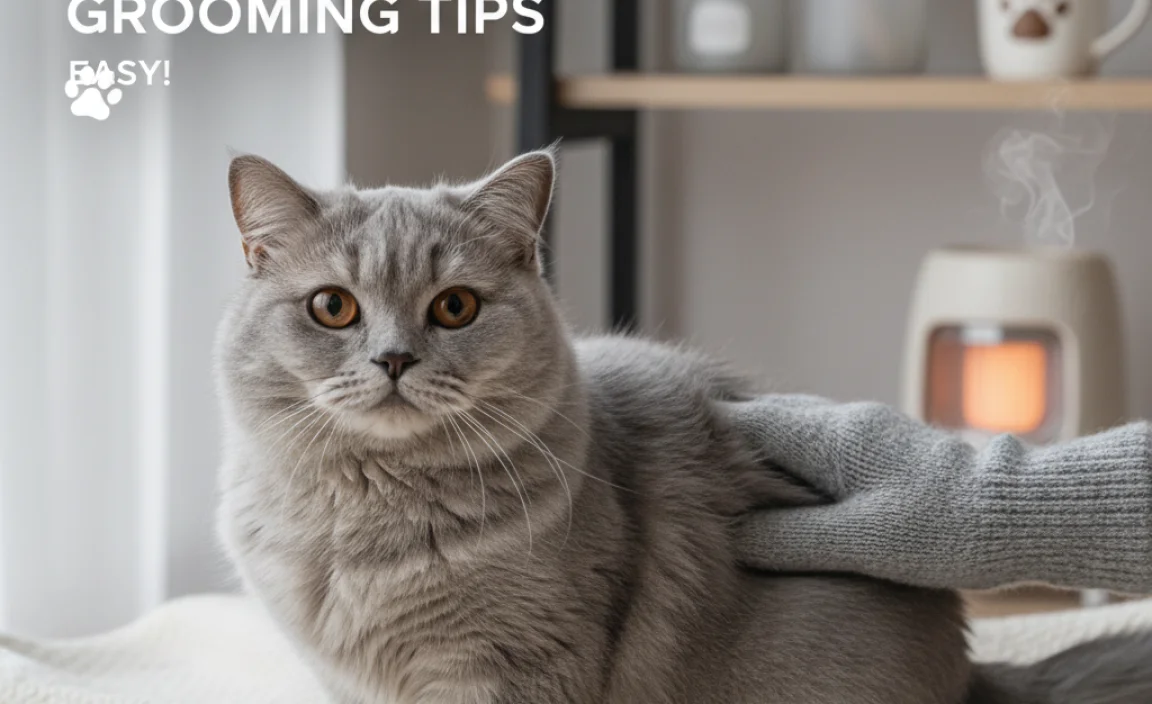
The British Shorthair’s coat is one of its most distinguishing features – dense, plush, and oh-so-cuddly! But as winter approaches, this coat undergoes a significant transformation. Understanding these changes is the first step in adapting your grooming routine.
The Winter Coat Thickening
As the days get shorter and temperatures drop, your British Shorthair’s body responds by growing a thicker undercoat. This natural adaptation provides insulation against the cold, helping them stay warm even in chilly environments. However, this thicker coat also means more shedding and a greater risk of matting, especially in areas like the armpits and belly.
Increased Shedding
While British Shorthairs are moderate shedders year-round, shedding tends to increase during the transition to and from winter. The old summer coat needs to make way for the new winter coat, and then shed again as spring arrives. Regular grooming becomes even more crucial to manage this extra fur and prevent hairballs.
Dry Skin Issues
Indoor heating systems can create a dry environment inside your home, which can strip moisture from your cat’s skin and coat. This can lead to dry, itchy skin, dandruff, and even skin irritation. Proper hydration and grooming practices can help combat these issues.
Essential Winter Grooming Tools
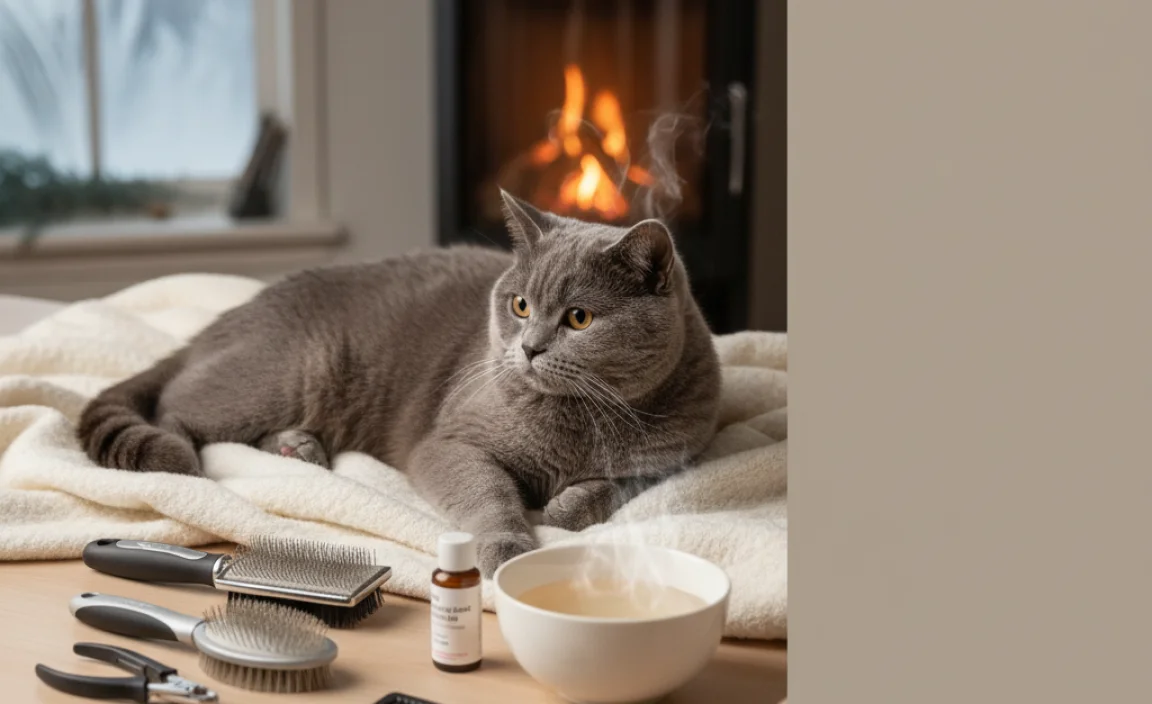
Having the right tools on hand can make winter grooming a much more efficient and enjoyable experience for both you and your British Shorthair. Here’s a list of essential grooming tools to have in your arsenal:
- Slicker Brush: Perfect for removing loose fur and preventing mats, especially in the thicker winter coat.
- Metal Comb: Use a wide-toothed metal comb to detangle knots and mats gently.
- Deshedding Tool: A deshedding tool can help remove a significant amount of loose undercoat, reducing shedding around the house.
- Soft Bristle Brush: A soft bristle brush is great for finishing the grooming session, smoothing the coat, and distributing natural oils.
- Pet Wipes: Use pet wipes to clean paws after outdoor excursions and to spot-clean any dirt or debris.
- Humidifier: A humidifier can help combat dry indoor air and keep your cat’s skin moisturized.
- Nail Clippers: Keep your cat’s nails trimmed to prevent them from getting snagged on furniture or carpets.
Step-by-Step Winter Grooming Guide
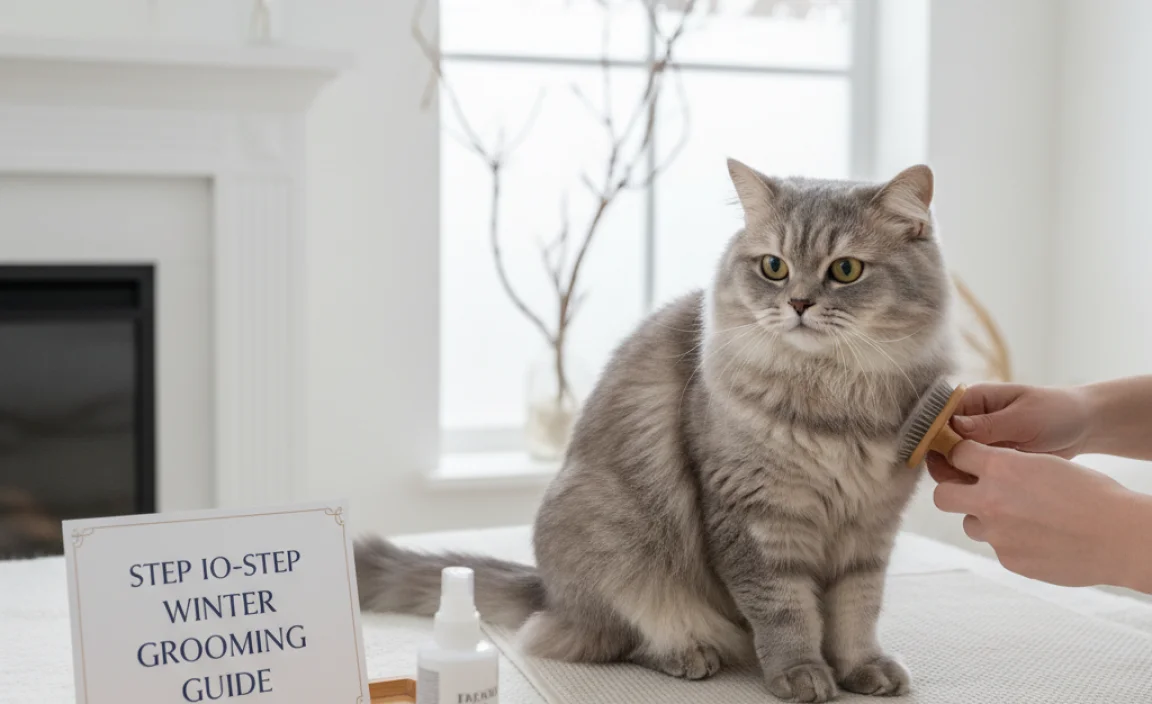
Now that you understand the challenges of winter grooming and have the right tools, let’s dive into a step-by-step guide to keep your British Shorthair looking and feeling their best.
Step 1: Regular Brushing (2-3 Times a Week)
Consistent brushing is the cornerstone of winter grooming. Aim to brush your British Shorthair 2-3 times a week to remove loose fur, prevent mats, and stimulate blood circulation. Use a slicker brush to gently work through the coat, paying extra attention to areas prone to matting, such as the armpits, belly, and behind the ears.
Pro Tip: Make grooming a positive experience by offering treats and praise during the session. Start with short sessions and gradually increase the duration as your cat becomes more comfortable.
Step 2: Detangling Knots and Mats
Despite your best efforts, knots and mats can still form, especially in the thicker winter coat. Use a wide-toothed metal comb to gently detangle these problem areas. Start at the end of the knot and work your way towards the skin, using short, gentle strokes. If the mat is too severe, you may need to carefully trim it with scissors, being extra cautious not to cut the skin.
Safety First: Always use blunt-nosed scissors designed for pet grooming to avoid accidental injuries.
Step 3: Deshedding (Once a Week)
A deshedding tool can be a lifesaver during the winter months when shedding increases. Use it once a week to remove a significant amount of loose undercoat. Follow the manufacturer’s instructions and be gentle, as excessive deshedding can irritate the skin.
Step 4: Bathing (Only When Necessary)
Bathing your British Shorthair too frequently can strip their skin of natural oils, leading to dryness and irritation. Only bathe them when necessary, such as if they get into something messy or develop a strong odor. Use a gentle, moisturizing cat shampoo and rinse thoroughly. Be sure to dry them completely with a soft towel or a pet-safe blow dryer on a low setting to prevent them from getting chilled.
Bath Time Tips: Make bath time less stressful by preparing everything in advance, using lukewarm water, and offering treats and praise. Consider having someone assist you to make the process smoother.
Step 5: Paw Care
Winter weather can be harsh on your cat’s paws. Snow, ice, and salt can cause dryness, cracking, and irritation. Wipe their paws with pet wipes after outdoor excursions to remove any salt or debris. You can also apply a paw balm to keep their paws moisturized and protected.
Step 6: Nail Trimming
Regular nail trimming is essential year-round, but it’s especially important during the winter months when your cat may be less active. Trim their nails every 2-3 weeks to prevent them from getting too long and snagging on furniture or carpets. Use pet-specific nail clippers and be careful not to cut the quick (the pink part of the nail that contains blood vessels and nerves). If you’re unsure how to trim your cat’s nails, ask your veterinarian or a professional groomer for guidance.
Step 7: Monitor Skin Health
Keep a close eye on your British Shorthair’s skin for any signs of dryness, flakiness, redness, or irritation. If you notice any of these issues, consult your veterinarian. They may recommend a moisturizing shampoo, a dietary supplement, or other treatments to address the problem.
Dietary Adjustments for Winter

Grooming isn’t the only aspect of care that needs adjustment during winter. Your British Shorthair’s diet might also need some tweaking to accommodate changes in activity levels and to support their overall health.
Adjusting Food Portions
Many cats become less active during the winter months, spending more time indoors and lounging around. This decrease in activity can lead to weight gain. To prevent this, you may need to reduce your cat’s daily food portions slightly. Monitor their weight and adjust their food intake accordingly.
Hydration is Key
Just like humans, cats can become dehydrated during the winter months, especially when indoor heating systems are running. Make sure your British Shorthair always has access to fresh, clean water. You can also encourage them to drink more by providing a water fountain or adding a little bit of water to their food.
Omega-3 Fatty Acids
Consider adding an omega-3 fatty acid supplement to your cat’s diet. Omega-3s can help improve skin and coat health, reduce inflammation, and support overall well-being. Consult your veterinarian before adding any new supplements to your cat’s diet.
Creating a Cozy Winter Environment
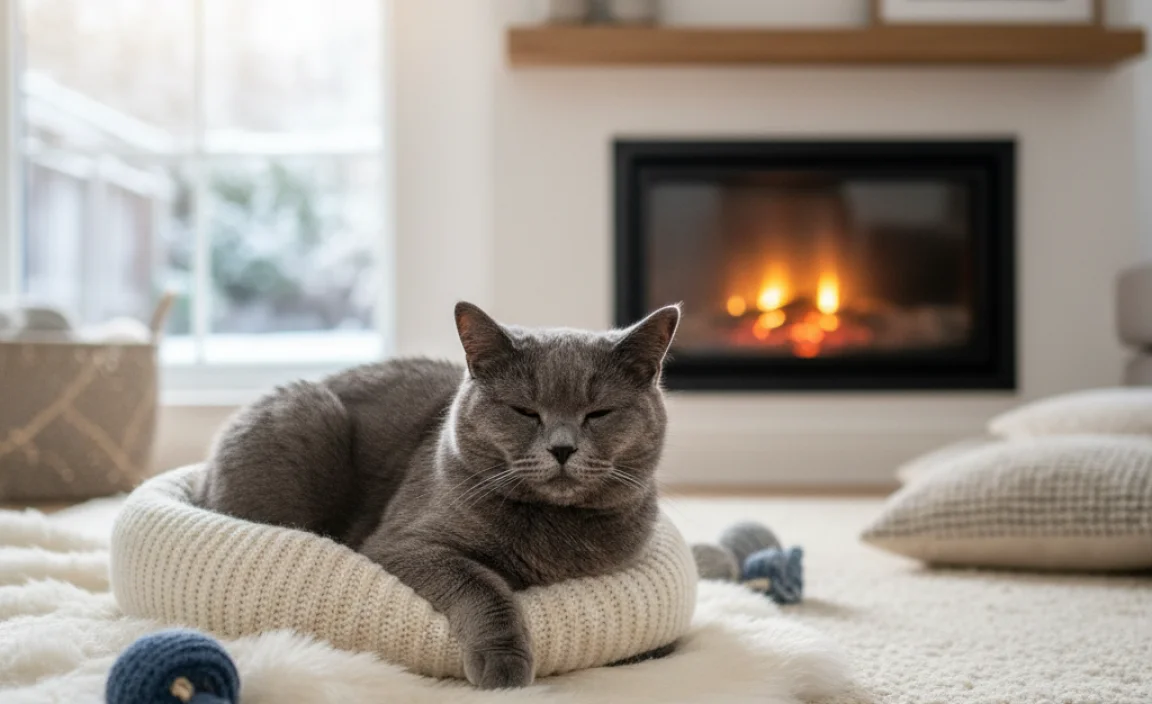
In addition to grooming and dietary adjustments, creating a cozy and comfortable indoor environment is essential for your British Shorthair’s well-being during the winter months.
Provide Warm Bedding
Make sure your cat has access to plenty of warm and comfortable bedding. Place beds in sunny spots or near radiators to provide extra warmth. You can also add a heated cat bed for ultimate comfort.
Maintain Indoor Humidity
As mentioned earlier, dry indoor air can wreak havoc on your cat’s skin and coat. Use a humidifier to maintain a comfortable humidity level in your home. Aim for a humidity level of around 40-50%.
Safe Outdoor Access
If your British Shorthair enjoys spending time outdoors, make sure they have safe access to the outside world. Clear snow and ice from walkways and provide a sheltered area where they can escape the elements. Limit their outdoor time during extreme cold or inclement weather.
Winter Health Concerns to Watch Out For
Winter can bring specific health challenges for cats. Being aware of these potential issues can help you take preventative measures and seek veterinary care when needed.
Respiratory Issues
Dry indoor air can irritate your cat’s respiratory system, making them more susceptible to respiratory infections. Watch out for signs like coughing, sneezing, runny nose, or labored breathing. If you notice any of these symptoms, consult your veterinarian.
Arthritis and Joint Pain
Cold weather can exacerbate arthritis and joint pain in older cats. Provide warm bedding and consider adding a joint supplement to their diet. Talk to your veterinarian about pain management options if your cat is showing signs of discomfort.
Hypothermia
Although British Shorthairs have thick coats, they are still susceptible to hypothermia if exposed to extreme cold for extended periods. Limit their outdoor time during cold weather and watch out for signs of hypothermia, such as shivering, lethargy, and pale gums. If you suspect your cat has hypothermia, seek immediate veterinary care.
Toxicity from Antifreeze
Antifreeze is highly toxic to cats and can cause kidney failure if ingested. Keep antifreeze containers tightly sealed and out of reach of your cat. Clean up any spills immediately and prevent your cat from accessing areas where antifreeze may be present, such as driveways and garages. If you suspect your cat has ingested antifreeze, seek immediate veterinary care.
Table: Winter Grooming and Health Checklist for British Shorthairs
| Area of Focus | Action | Frequency |
|---|---|---|
| Brushing | Remove loose fur, prevent mats | 2-3 times per week |
| Detangling | Gently remove knots and mats | As needed |
| Deshedding | Remove excess undercoat | Once a week |
| Bathing | Clean when necessary | Only when needed |
| Paw Care | Wipe paws, apply balm | After outdoor exposure |
| Nail Trimming | Trim nails to prevent snagging | Every 2-3 weeks |
| Skin Monitoring | Check for dryness, irritation | Daily |
| Diet | Adjust portions, ensure hydration | Daily |
| Environment | Provide warm bedding, maintain humidity | Continuously |
| Health | Monitor for respiratory issues, arthritis | Daily |
Table: Common Winter Health Issues in British Shorthairs
| Health Issue | Symptoms | Action |
|---|---|---|
| Respiratory Issues | Coughing, sneezing, runny nose | Consult veterinarian |
| Arthritis | Limping, stiffness, reluctance to move | Consult veterinarian |
| Hypothermia | Shivering, lethargy, pale gums | Seek immediate veterinary care |
| Antifreeze Poisoning | Vomiting, seizures, incoordination | Seek immediate veterinary care |
Frequently Asked Questions (FAQs)
1. How often should I brush my British Shorthair in the winter?
You should aim to brush your British Shorthair 2-3 times a week during the winter months. This helps to remove loose fur, prevent matting, and stimulate blood circulation, which is especially important when their coat is thicker.
2. Can I bathe my British Shorthair more often in the winter to help with dry skin?
No, bathing your British Shorthair too often can actually worsen dry skin. Only bathe them when necessary, such as if they get dirty or develop an odor. Use a moisturizing cat shampoo and be sure to dry them thoroughly.
3. How can I prevent my British Shorthair from getting fat in the winter?
Reduce their daily food portions slightly to account for decreased activity levels. Monitor their weight regularly and adjust their food intake as needed. Ensure they still have opportunities for play and exercise indoors.
4. Is it safe for my British Shorthair to go outside in the winter?
Yes, but with precautions. Limit their outdoor time during extreme cold or inclement weather. Clear snow and ice from walkways and provide a sheltered area where they can escape the elements. Wipe their paws with pet wipes after they come inside to remove any salt or debris.
5. What are some signs that my British Shorthair has dry skin?
Signs of dry skin include flakiness, itchiness, redness, and excessive grooming. If you notice these symptoms, consult your veterinarian.
6. How can I keep my British Shorthair warm indoors during the winter?
Provide warm bedding in sunny spots or near radiators. You can also use a heated cat bed for extra comfort. Ensure your home is adequately heated and that there are no drafts.
7. Should I give my British Shorthair any supplements during the winter?
Consider adding an omega-3 fatty acid supplement to their diet to support skin and coat health. However, always consult your veterinarian before adding any new supplements to your cat’s diet. They can advise you on the appropriate dosage and ensure it’s safe for your cat.
Conclusion
Winter doesn’t have to be a challenging season for your British Shorthair’s grooming routine. By understanding the changes in their coat, using the right tools, and following a consistent grooming schedule, you can keep your feline friend looking and feeling their best. Remember to adjust their diet to prevent weight gain, create a cozy indoor environment, and monitor for any signs of winter-related health issues.
With a little extra care and attention, you and your British Shorthair can enjoy a happy and healthy winter season together. So, grab your brushes, turn up the heat, and get ready for some cozy cuddles with your beautifully groomed kitty!


